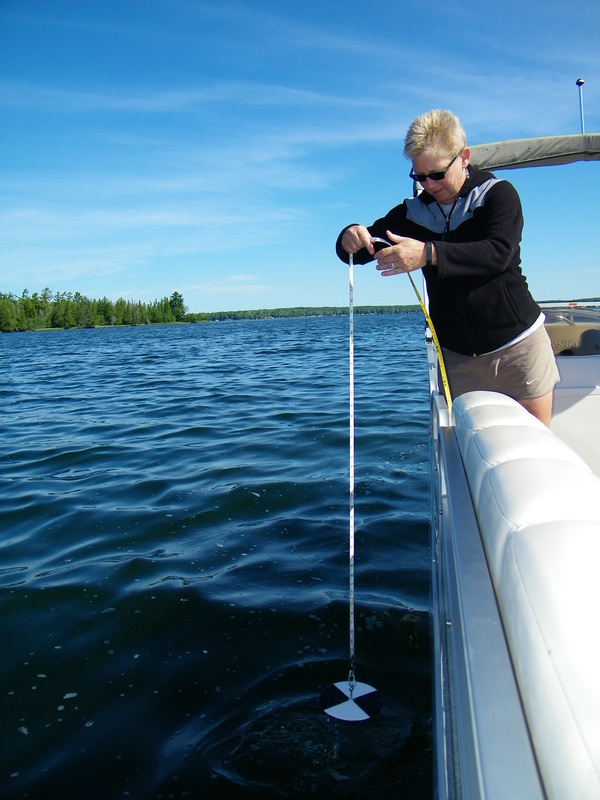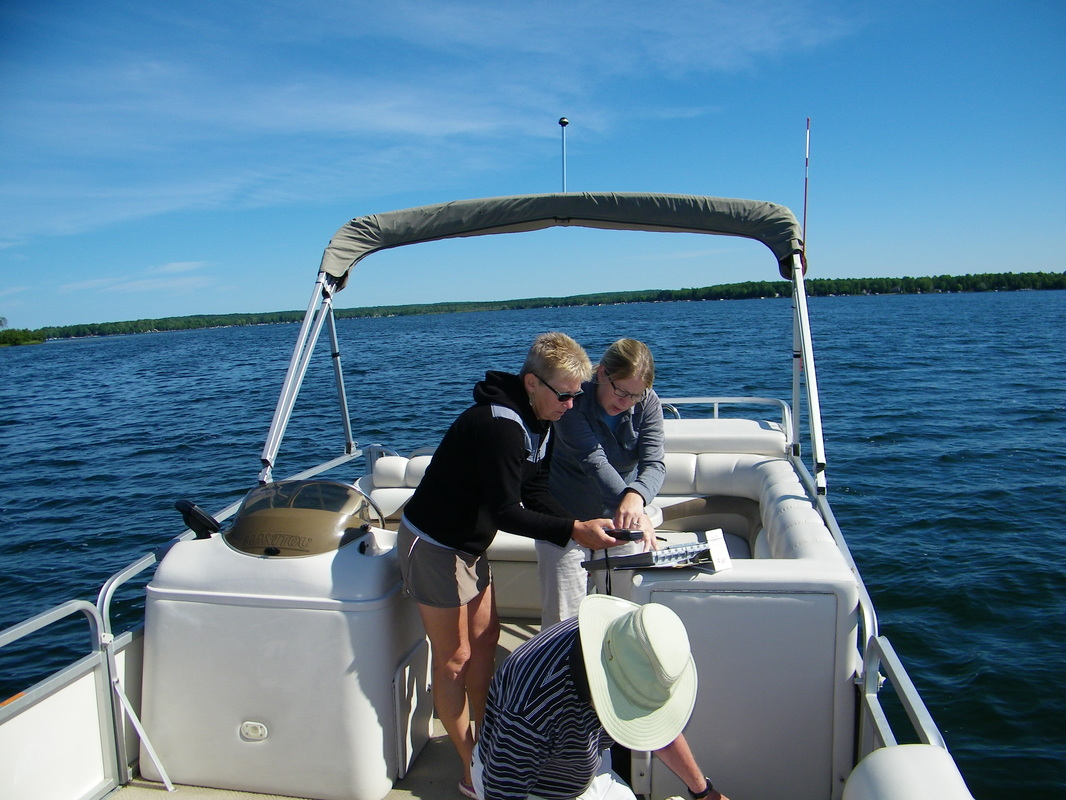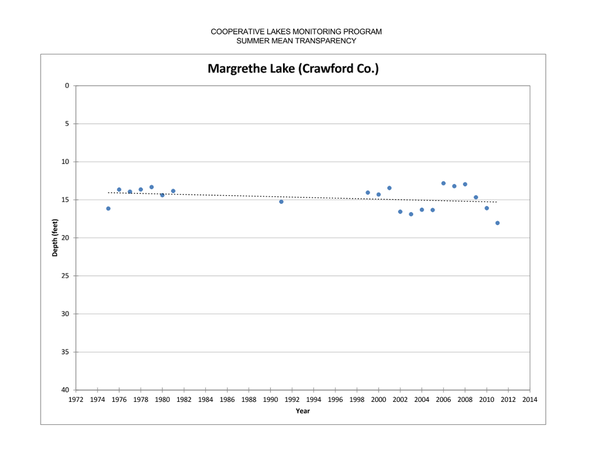Lake Water Quality
DEQ and Directors Measure Water Quality- July, 2015
Joe Porter and Sandra Michalik took Marcy K. from the DEQ and Jo Latimore from MSU out on the lake to do side by side water measurements. Sandra and Marcy were within 1/2 ft. in the measuring of clarity with the secchi disk. We are awaiting the results of the comparison between Joe and Marcy's chlorophyll and phosphorus measurements.
Why is water quality important?
When pollutants or sediments enter the lake, they prevent sunlight from reaching deeper into the water. Without sunlight, aquatic plants cannot grow. Aquatic plants provide food, oxygen, and a place to live for the many fish and other animals that live in the lake. When too many nutrients, such as nitrogen and phosphorous, get into the water, they stimulate the growth of all aquatic plants, including Eurasian water milfoil. Too much algae and greater weed growth lowers oxygen levels in the water, causing a reduction in fish populations. In order to maintain a healthy ecosystem, we need to ensure Lake Margrethe has clean water!
What can I do to protect the water quality of our lake?
Prescription Drug Disposal
In July, the Department of Environmental Quality (DEQ), awarded the Crawford County Commission on Aging a grant to install 2 drop boxes in Grayling for unused, unwanted or expired prescription drugs. These units are now in place and available to use outside at both the County Sheriff's Department and the Grayling City Hall. This means you can drop off your prescription drugs at anytime- 24/7!
The flyer above outlines specifically how to do it safely and legally. This will help us keep our lakes and rivers free of damaging chemicals. Please do your part and dispose of your prescription drugs properly. DO NOT flush them down the toilet. |
Fertilizer Use Near Lake Margrethe
_
It is recommended that residents living on or near Lake
Margrethe avoid the use of lawn or garden fertilizers. If fertilizer must be used, it is important
that the fertilizer NOT contain
phosphorus. Some states now ban
the use of fertilizers containing phosphorus near lakes, rivers, streams and
ponds because phosphorus does stimulate the growth of all aquatic plants,
including Eurasian water milfoil. Areas of the lake, which produce noticeably heavier weed growth,
probably have too much phosphorus run off. Only one pound of phosphorus can result in hundreds of pounds of algae. Higher phosphorus levels may also mean
fewer fish because too much algae and greater weed growth lowers oxygen levels
in the water causing a reduction and limitation of existing fish populations.
Any phosphorus free fertilizer can grow a healthy lawn, since nitrogen will promote a thick, healthy lawn, which reduces run-off and decreases soil erosion. If phosphorus is applied directly to your lawn, much of it will run-off before it has the opportunity to penetrate the soil. That means it will end up in the lake, where boat traffic will keep the phosphorus stirred up, preventing its natural elimination. On any bag of fertilizer there is a string of 3 numbers and the middle number is phosphorus. That middle number should always be 0. Milorganite, thought by some to be a natural, organic, alternative fertilizer should also be avoided because it has a phosphorus number of 2. Mulched leaves, grass clippings, and soil are all natural sources of phosphorus, which if left on lawns provide a natural source of phosphorus but should be removed from hard surfaces where they can be washed into the lake, ditches, and storm drains. *Information used in this article comes from the Minnesota Department of Agriculture and the Indiana Lake Management Society. Biodegradable Products
_The use of biodegradable products in and around Lake Margrethe is very
important and often overlooked! If you ever use soaps, shampoos, or
sunscreen in and around the lake please consider switching to a
biodegradable product! We do not want the chemicals, preservatives, and plastics that are often found in ordinary cosmetic products in our lake!
"Biodegradable products are those that can be decomposed by microbes and other natural biological processes. Exposure to moisture, air and the elements enhance that breakdown". -Lexa W. Lee, Demand Media Alternative products are surprisingly easy to find if you know where to look. Biodegradable sunscreen is available at Target. Garnier Fructis' line of biodegradable shampoo is available at many grocery or drug stores. Other products are available for purchase online. Examples of biodegradable products include: Dr. Bronner's Garnier Fructis' Pure Clean Shampoo & Conditioner Sunscreen Why Litter Campaign
_In recent walks and drives on the roads and paths around Lake Margrethe,
you may have noticed signs posted at various locations which ask WHY
LITTER?
Your Lake Margrethe Property Owners Association has been concerned about the refuse being dumped on our road sides and on the common use areas around the lake. We noticed that there was a considerable amount of trash left on the campground sand dunes and along the roads around the lake. We, therefore, decided to invest in signs which could be posted at various locations around our lake to discourage those persons who throw trash out of their car and truck windows. We have purchased 10 signs and have placed them on the roads and at the campground near Lake Margrethe. It is our hope that these signs may remind everyone to keep trash in cars and trucks until it can be disposed of properly. At the end of the tourist season, these signs will be collected and used again next year. Please join us in our efforts to keep Lake Margrethe and the surrounding area beautiful! |
Measuring Water Quality
_LMPOA members volunteer their time to monitor water quality a minimum of
twice per month. A Secchi disk is often used to obtain measurements.
The Secchi disk, created in 1865 by Pietro Angelo Secchi, is a circular black and white disk used to measure water transparency in oceans and lakes.
Appropriate water quality is fundamentally important for fish and
aquatic plants, and muddy water limits production of both.
To obtain a measurement, the disc is mounted on a pole or line, and lowered slowly down in the water. Inch or centimeter intervals are marked on the line. The depth at which the black and white pattern on the disk is no longer visible is taken as a measure of the transparency of the water. Secchi disk readings do not provide an exact measure of transparency, as there can be errors due to the sun's glare on the water, or one person may see the disk at one depth, but another, with better eyesight, may see it at a greater depth. However a Secchi disk is an inexpensive and straightforward method of measuring water clarity. Because of the potential for variation between practitioners, methods should be standardized as much as possible. Secchi disk measurements are most accurate when taken on relatively calm, sunny days during the middle of the day. Regularly recording Secchi disk measurements indicate water clarity trends before and after management. They help monitor management success and can be useful for determining whether and when any additional treatments are necessary. The Cooperative Lakes Monitoring Program
_There is a year-round need to monitor the water level and water quality of Lake Margrethe. The
Cooperative Lakes Monitoring Program (CLMP) has been an important
component of Michigan's inland lakes monitoring program for over 35
years, which makes it the second oldest volunteer monitoring program for
lakes in the country. The primary purpose of this cooperative program
is to help citizen volunteers monitor indicators of water quality in
their lake and document changes in lake quality over time. The goals of
the CLMP are:
Since 1992, the Michigan Lake and Stream Associations (MLSA) has administered the CLMP jointly with the Michigan Department of Environmental Quality (DEQ) under a Memorandum of Understanding. The MLSA will continue to administer this program under the Michigan Clean Water Corps. LMPOA is an active member in this monitoring effort. |








